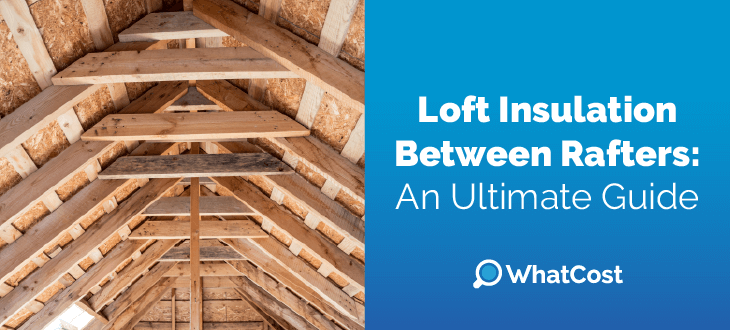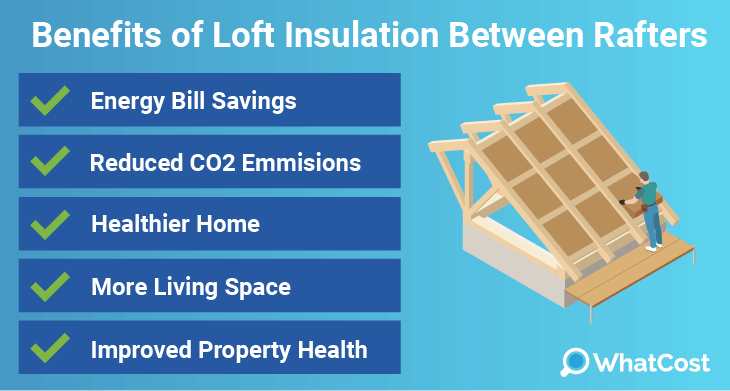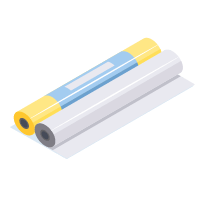- whatcost.co.uk
- Home Insulation
- Loft Insulation
- Rafter Loft Insulation
Loft Insulation Between Rafters: Your Complete Guide


- Loft rafter insulation costs around £930 in a typical semi-detached UK home.
- Loft rafter insulation in a semi-detached home can save up to £225 on annual energy bills.
- Loft rafter insulation retains heat in your loft, allowing you to use it as living space.
Do you ever struggle to keep your home warm and dry in the winter? Loft insulation between rafters offers a powerful solution to a problem that’s all too common in the UK. Loft rafter insulation helps tackle heat loss and slash energy bills, all with a single affordable investment.
With loft rafter insulation, you can reduce your annual fuel bills by up to £225, and minimise your carbon footprint by 0.6 tonnes in a standard semi-detached UK home.
But loft insulation goes beyond simple energy efficiency and a temperature-regulated home. Unlike traditional loft joist insulation, insulating your rafters allows you to transform your loft into a usable living space, seamlessly integrating it with your home's thermal envelope.
If you’re wondering how to install loft insulation between rafters, you’re in the right place. This complete guide by WhatCost will give you all the knowledge you need, including the pros and cons of rafter insulation, various insulation materials, and the step-by-step process.
Ready to get your loft rafters insulated? Save yourself from endless hours surfing the web for the right installer and let WhatCost handle the hard work! Just spend 30 seconds filling out our online form, and we’ll send you 3 free home-tailored quotes from our network of professional installers in your area. Start now to secure the best bargain for your home!
- Describe your needs
- Get free quotes
- Choose the best offer
It only takes 30 seconds



Why is loft insulation between rafters important?

Loft insulation between rafters - also called warm loft insulation - is an impressively cost-effective home upgrade that brings about a wealth of benefits to your home life. More than a quarter of your home's heat loss occurs through your roof and loft alone.
By installing roof rafter insulation in your home, you can improve the quality of your life and financial security but can also enjoy advantages such as:
- Slash energy bills: Proper insulation keeps your home's warmth from escaping, forcing your heating system to work less. This translates to significant energy bill savings of up to £370 annually for detached UK homes.
- Reduce your carbon footprint: Housing in the UK is notorious for its low energy efficiency and poor insulation. Rafter insulation helps you become a more eco-conscious homeowner. By trapping heat better, you can potentially cut your CO2 emissions by a staggering 1 tonne per year in a detached UK home.
- Create a healthier environment: Damp and drafty lofts suffer from mould and rot. Not only does this damage your property, but it can also trigger respiratory problems and weaken your immune system when you get ill. Insulation regulates your home's temperature, keeping these health hazards at bay and promoting a healthier home.
- Unlock more living space: Unlike some attic insulation methods, rafter insulation is installed directly onto the underside of the roof, keeping your loft space warm and usable. This opens doors for creating a cosy living area, a home office, or even a fun recreational room!
- Boost your property value: Investing in energy efficiency improvements like rafter insulation raises your home's Energy Performance Certificate (EPC) rating. A higher EPC rating translates to a more valuable property on the market, should you ever choose to sell or rent it.
While some believe rafter insulation soundproofs your loft, it primarily addresses thermal insulation. For noise reduction, different solutions are needed.
Rafter insulation offers one of the best returns on investment for home improvement projects. It enhances comfort, saves you money, and adds value to your property. It's a triple threat win for your wallet, your health, and the environment.
What is the best loft insulation between rafters?
Generally speaking, mineral wool insulation is considered the most popular and cost-effective choice for insulating between rafters, making it one of the best loft insulation options on the market. The price you pay is balanced with well-performing heat resistance, ease of installation, and sustainable production.
Either way, the best insulation for loft jobs depends on several factors worth exploring to make an informed decision. Here are some key factors worth considering:
- Budget: Mineral wool offers a great balance of affordability and performance. However, if you prioritise long-term savings with high-grade heat retention, spray foam might be worth considering despite the higher upfront cost. As a general rule of thumb, insulation costs fluctuate based on the heat retention effectiveness of your chosen material.
- Loft type: Is your loft used for storage or as a living space? Certain materials, like reflective foil, are better suited for unheated lofts due to performance while living space insulation would require more robust measures.
- Existing insulation: Do you already have some insulation in place? Some materials, like rigid board insulation, can be layered on top of existing insulation to increase R-value (thermal resistance). Homes with mineral wool insulation in place can also save money by just topping up to the government-recommended 270mm thickness.
- Installation difficulty: DIY enthusiasts might favour user-friendly options like mineral wool batts given the ease of installation. Spray foam insulation on the other hand requires professional installation with industry-specialised equipment.
These factors can guide you towards a decision best suited for your home. Better yet, conducting a loft assessment with a professional installer is a great way to get a thorough understanding of your best options. Now, let’s look at some of the most popular insulation materials on the market for loft rafter insulation.
Mineral wool

Mineral wool, made from rock or glass fibres, is a popular selection for between rafter insulation. Its affordability, availability, and eco-friendly credentials make it a great option for many homeowners. Typically found in batts or sheets, mineral wool offers a budget-friendly solution, costing around £13 – £17.5 per square metre of material.
Mineral wool comes in sheets typically 25 to 150mm thick. These can be cut to size and fit between and over your roof rafters. Installation is straightforward, making it suitable for DIY enthusiasts. Once secured with netting, the insulation is covered with plasterboard for a clean look.
- Cost-effective: Mineral wool offers excellent value for money compared to other insulating materials.
- Sustainable choice: Mineral wool is often produced using sustainable production methods and recycled materials, making mineral wool an eco-friendly option.
- DIY-friendly installation: The ease of cutting and fitting mineral wool sheets allows for DIY installation, potentially saving you money on labour costs.
- Limited reach: Mineral wool sheets are not ideal for filling crevices and irregularly shaped areas. Compression can reduce its effectiveness, so careful installation is crucial.
- Skin and respiratory irritation: Mineral wool fibres can irritate the skin, eyes, and respiratory system. Protective gear, like gloves, masks, and long sleeves, is essential during handling and installation.
Fibreglass

Fiberglass is a cost-effective and widely popular insulation material made from recycled glass. Often sold in pre-cut batts or sheets, it’s installed similarly to mineral wool and sheep wool. At around £10 per square metre, fibreglass is a budget-friendly choice for homeowners.
Fiberglass can be sustainably produced using recycled glass and offers recyclable properties itself, making it an eco-conscious insulation option when disposed of properly.
- Cost-effective: Fiberglass boasts one of the most competitive prices in the insulation market.
- Fire-resistant: Most fibreglass options come with fire-resistant properties, adding a layer of safety to your home.
- Mould-resistant: Fiberglass naturally resists mould growth, reducing maintenance concerns.
- Skin and respiratory irritation: Fiberglass particles can irritate the skin, eyes, and lungs if not handled with proper protective gear like gloves, masks, and safety glasses.
- Moisture sensitivity: Fiberglass insulation isn’t the most effective at repelling moisture, potentially leading to condensation issues if not installed with a vapour barrier.
Rigid boards

Loft insulation boards between rafters offer a convenient way to insulate your loft that is easy and mess-free. These pre-cut sheets fit snugly between your rafters, causing minimal mess during installation.
Synthetic Boards (EPS Polystyrene & PIR) boast excellent heat retention and come at a budget-friendly price point of £5 - £15 per m². However, cork boards offer a more sustainable alternative made from recycled materials. These boards are just as effective insulators but cost slightly more than synthetics at around £17 - £22 per m².
- High performance: Rafter insulation boards generally require less thickness compared to bulkier blanket insulation (like mineral wool) to achieve the same level of thermal resistance.
- No mess: Rigid boards are some of the least messy to install, creating no dust, or airborne particles like mineral wool and fibreglass.
- Cost vs. sustainability: While synthetics offer affordability, their environmental impact is a significant drawback. Cork provides a more eco-friendly option at a slightly higher cost.
- Health and safety: Be mindful of potential VOC emissions with some synthetic boards. Prioritise options with low VOC ratings for a healthier indoor environment.
Foil insulation

Foil insulation, also called reflective insulation, is a cost-effective solution for your roof rafters. Typically priced between £3 to £4 per square metre, rafter insulation foil consists of one or more layers of aluminium bonded with foam insulation.
This combination reflects up to 97% of radiant heat, helping to regulate temperatures in your attic or loft space.
- Budget-friendly: Foil insulation is one of the most affordable insulation options available on the market.
- Durable: Made with aluminium, it offers long-lasting performance and won’t degrade over time. It’s quite resistant to mould, rot and general damage.
- Moisture resistant: Foil acts as a vapour barrier, helping to prevent moisture buildup and condensation within your roof structure.
- Maintenance: To maintain its reflective properties and effectiveness, foil insulation requires regular cleaning to remove dust and debris.
- Electrical safety: It’s important to avoid bringing the foil in contact with live wires, as the foil is conductive and can pose an electrical hazard.
- Climate and effectiveness: While effective at reflecting radiant heat, foil insulation alone might not be sufficient for colder climates. Consider combining it with traditional insulation materials like fibreglass or rock wool for optimal thermal performance.
Spray foam

Spray foam insulation offers a compelling solution for homeowners seeking exceptional thermal performance. Unlike traditional methods, spray foam expands to fill every nook and cranny, creating a virtually impenetrable barrier against heat transfer. This translates to significant advantages for your home's comfort and energy efficiency.
While there are cost and environmental considerations, the potential energy savings and long-term benefits can make it a worthwhile investment. It's essential to weigh the advantages against your needs and priorities to see if spray foam is the right choice for your project.
- Reduced energy bills: Spray foam boasts one of the highest R-values (a measure of thermal resistance) per inch of thickness compared to other insulation materials. This translates to significant savings on heating and cooling costs, potentially reaching up to a 50% drop in energy bills.
- Faster installation: Spray foam installation is considerably faster than other insulation methods, typically completed within a day, minimising disruption to your daily routine.
- Structural reinforcement: Certain types of spray foam offer additional structural support to your roof due to its expansive and adhesive properties.
- Cost: Spray foam insulation is a premium product with a higher initial investment compared to traditional methods. However, the long-term energy savings can offset the initial cost over time.
- Environmental impact: The manufacturing process of most spray foam types can have environmental drawbacks and produce off-gases that are harmful to the environment.
- Professional installation: Due to the specialised equipment and expertise required, spray foam installation should only be performed by certified professionals to ensure optimal results and safety. This can cost more as DIY installation is not possible.
What are the building regulations for loft insulation between rafters?
Ensuring your loft insulation meets building regulations is crucial for maximising energy savings and avoiding potential problems. Insulation between rafters building regulations mainly aims to ensure that the insulation is effective and safely installed for long-term benefits. Here's a breakdown of the key requirements:
- U-value target: The UK regulations aim for a U-value of around 0.20 W/m²K for loft insulation jobs. To achieve this, you'll need at least 270mm thickness of mineral wool or similar insulation, with 300mm recommended for optimal performance.
- Breathing space: Proper ventilation is vital to prevent moisture build-up, which can lead to mould, rot, and structural damage. Building regulations recommend a minimum air gap of 25mm, ideally 50mm, between the insulation and the underside of your roof tiles.
- Permits and permissions: Loft insulation between rafters usually won't require local permission, but a professional installer can provide peace of mind. They can handle necessary notices on your behalf and ensure the project complies with regulations.
By following these loft insulation between rafters regulations, you can ensure your rafter insulation is both effective and compliant, keeping your home warm and saving you money on energy bills.
How you can install loft insulation between rafters
Want to keep your home warm and energy bills low? Pitched roof insulation between rafters is a fantastic way to achieve both. In this section, we’ll show you how to insulate an attic roof rafters per each loft insulation material:
- Blanket insulation: This popular choice, such as mineral wool or fibreglass, offers excellent insulation properties. Aim for a thickness of at least 270mm, ensuring it sits snugly between and over your rafters. Remember to leave a 25mm - 50mm air gap for proper ventilation between the insulation and the underside of your roof. Secure the insulation with netting to prevent compression and maintain its effectiveness. Finally, finish the look with plasterboard for a clean inner ceiling.
- Rigid boards: These pre-cut boards made from PIR, polystyrene, or cork, offer a space-saving solution. Cut them to fit tightly between your rafters, ensuring a snug fit that minimises the need for additional fixings. Staple the boards to the rafters for added security. Similar to blanket insulation, maintain a 25mm - 50mm air gap for ventilation.
- Spray foam: This specialist application requires professional installation. A trained applicator uses a hose to spray expanding foam between your rafters, creating a seamless and highly effective insulation layer. While the installation itself is quick (1-2 hours for a standard home), proper ventilation afterwards is needed to allow harmful fumes to escape the loft space.
While loft insulation installation can be a DIY project, loft insulation installers offer several advantages that outweigh your short-term cost savings:
- Expertise: Professionals ensure the job is done correctly, preventing costly repairs or structural damage down the line.
- Safety: Spray foam requires specific training and equipment. Professionals handle it safely and efficiently.
- Building regulations: They ensure your insulation meets all current building regulations for optimal performance and safety.
A DIY approach might seem cost-effective initially, but the benefits of a professional installation often outweigh the initial investment. You’ll gain peace of mind knowing your home is properly insulated, saving you money on energy bills for decades to come.
Finding the right installer at the right price can be harder than it seems. It requires countless hours of research and vetting that most people simply don’t have time for. Luckily WhatCost can handle all the hard work for you at absolutely no cost!
Simply fill in our 30-second online form, and receive up to 3 free home-tailored quote prices from our network of accredited installers right in your area. The best part? There are no charges or extra obligations. Click below to begin securing the best bargain for your home.
- Describe your needs
- Get free quotes
- Choose the best offer
It only takes 30 seconds



FAQ
Loft insulation between rafters can indeed be used. This approach is called warm loft insulation, which incorporates your loft space into your home’s insulation envelope. That way, your loft can also be used as a living or recreational space rather than just storage.
Regarding cost, the best loft insulation between rafters is likely fibreglass insulation. Priced at just £10 per square metre, it’s a budget-friendly and effective insulator that’s easy to find, and even mould and fire-resistant. Much like mineral wool, you need safety gear such as goggles, gloves and respiratory masks to handle fibreglass due to its ability to irritate the skin in contact.
Loft insulation installation happens in various ways depending on your chosen loft insulation material. Blanket-style material such as mineral wool is the most popular approach, in which the insulation is added between the roof rafters, secured in place with netting, and covered with plasterboard. It’s important to use at least 270mm of mineral wool and leave a 50mm air gap between the roof underside and insulation material for optimal performance.
Generally speaking, you can’t have too much insulation in your loft, however after a certain thickness, it hardly makes a difference to increase it. The UK building regulations suggest a minimum 270mm thickness of mineral wool insulation, but up to 300mm thickness is considered an effective upgrade for attic insulation.

Akif has a keen interest in green home improvement solutions and the role of digital media in identifying climate trends. He aims to provide a multidisciplinary approach to content rooted in credible research and accuracy.
